|
Monthly Special Sales!
10%
- 50%
off on select items or pages.

Select
Subject Pages Below:

This
Month's Catalogue
Page.
Items
Just Received








Books
by Tom Tag












SS
Portland
Portland
Gale
Pendleton
Fort Mercer 1952 Chatham





























































Lighthouse
Blog
Climate
Change

| |
Royal
National Lifeboat Institution R.N.L.I.
We
are continually acquiring wonderful and rare original books, documents,
antiques and implements. Below are photos and information. Inquiries welcomed.
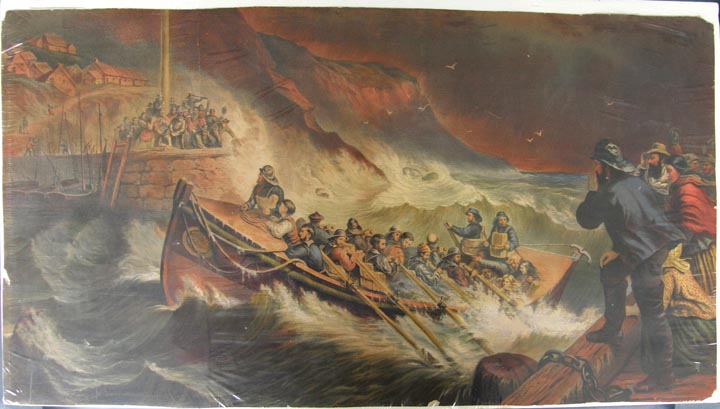
8385. [lithograph] c.1871-73. Superb
large 28”w x 15”h early full color lithograph of the Royal
National Lifeboat Institution’s lifeboat pulling into the harbor with its’
load of shipwreck victims. The image is quite large and details
clearly the boat and its crew, with the National Lifeboat Institution emblem on
its bow. On the shore villagers can bee seen cheering for the crew as they bring
in their cargo. This superb illustration was produced by Armstrong & Company
Lithographers, Boston and given out by with the Citizen & Round Table, a
publication of the time. Unfortunately, a fold at one time produced a slight
crease across the image, but when dry mounted and framed this will be nearly
invisible. This would be a wonderful addition to any museum display or to your
living room. (G). $144.
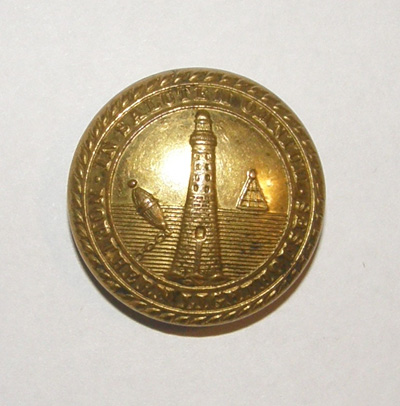
20121.
[uniform button]
Great Britain
, Northern Lighthouse Board. Most interesting 2-piece uniform button
of the Northern Lighthouse
Board
,
Great Britain
. Brass button depicts a large offshore masonry lighthouse, flanked by a bell
buoy and a spar buoy, encircled by the words “In Salutem Omnium, Northern
Lighthouses”. Backmarked “ Fast Shanks”. 23mm [15/16”]. Only lightly
worn, in good condition. A most interesting collectors’ item. (VG). $36.
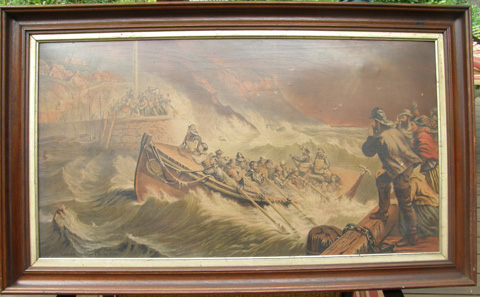 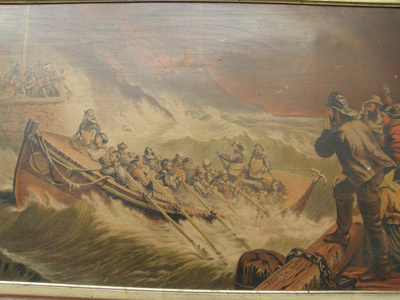
8385b.
[framed lithograph on linen] Royal National Lifeboat
Institution’s Lifeboat c.1871-73. Superb large 28 ½” x 16”
early full color lithograph on linen canvas of the Royal National Lifeboat
Institution’s lifeboat pulling into the harbor with its’ load of shipwreck
victims. The image is quite large and details clearly the boat and its crew,
with the National Lifeboat Institution emblem on its bow. On the shore villagers
can bee seen cheering for the crew as they bring in their cargo. This superb
illustration was produced by Armstrong & Company Lithographers,
Boston
and given out by with the Citizen & Round Table, a publication of the time.
In period 20” x 33” frame. Condition quite good, with only a few small
chips. This would be a wonderful addition to any museum display or to your
living room. (VG). $48.
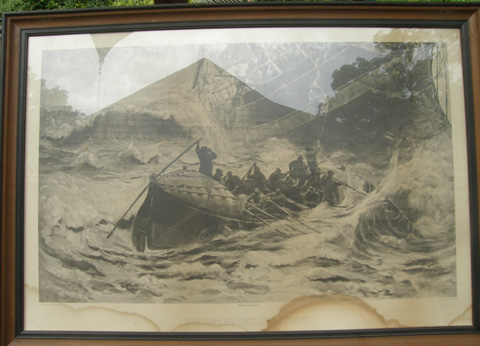
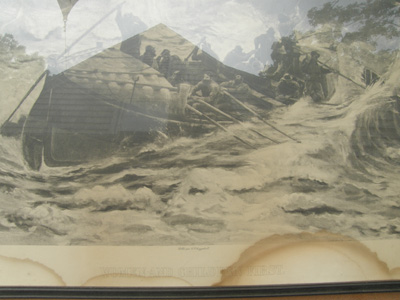
14191.
[photogravure print] WOMEN AND CHILDREN FIRST from
painting by T.M. Henry 1887. Photogravure by C.P. Coggeshall. Superb
large 23”h x 33”w framed b/w photogravure print shows the lifeboat crew as
they rescue passengers from a foundering ship at sea. The image is quite large
and details clearly the lifeboat and crew as they struggle in the towering seas.
In later frame. With some dark staining to bottom areas from moisture. (G+).
$48.

13451. (photo) Crew
of R.N.L.I. Life Boat Mary Stanford Heads Out for Fatal Rescue Attempt c.1928. Rare
early photo provides a rare view as the lifeboat crew pulls the R.N.L.I.
lifeboat from the station. All of the men shown here would lose their lives
while trying to save the crew of the vessel Alice of Riga. RNLB Mary Stanford
(ON 661) was a Liverpool-class lifeboat. The Lifeboat was launched in a
south-west gale with heavy rain squalls and heavy seas to the vessel Alice. News
was received that the crew of the Alice had been rescued by another vessel and
the recall signal was fired three times. Apparently the crew of the Lifeboat had
not seen it. As the Lifeboat was coming into harbour she was seen to capsize and
the whole of the 17-man crew perished. The Board of Trade Court of Enquiry later
concluded: "As there were no survivors of the crew, the cause of the
Lifeboat capsizing is a matter of conjecture, but from the evidence available we
are of the opinion that whilst attempting to make the Harbour on a strong flood
tide and in high and dangerous breaking sea, she was suddenly capsized and the
crew were thrown into the water, two men being entangled under the boat. The
broken water and heavy surf caused the loss of the crew". Every family in
the little fishing village lost one or more members in the disaster, practically
the whole male fishing population of the small town of Rye. Photo measures 8”
x 10” and is clear and close. Some edge wear, has been retouched in places for
publication. Dated for publication December 6, 1928. (VG). $38.

1418. Fry, Eric C. Life-Boat
Design & Development. David & Charles. 1975. 128p. DJ.
A detailed record of life-boat development in Britain spanning nearly 200 years,
from 1785 to the 1970s. Features of 33 different classes of lifeboats are shown
in 151 scale drawings and photos with detailed descriptions of each of the
types. Includes boats from the “Unimmergible” boats patented by Lionel Lukin
in 1785 to the 70-foot long-range Chyde Class and the high-speed inshore rescue
boats of the RNLI. Also includes sail plans, launching carriage details and a
diagrammatic explanation of R.A. Oakley’s method of self-righting by
transferrance of water ballast. Well done interesting reference. Overall clean,
tight, only light foxing to page edges. (VG+) $56.
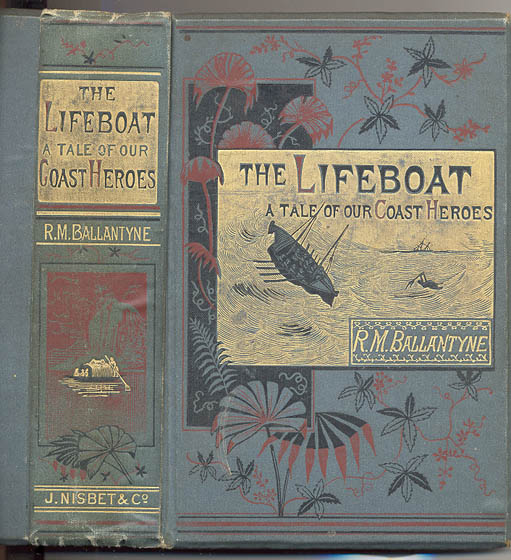
7109f. Ballantyne, R. M. THE
LIFEBOAT - A Tale of Our Coast Heroes. NY. 1864. 392p. Superb
brightly colored, embossed binding. In this scarce title, the author tells of
the work of the lifeboat in wreck and rescue with the aid of fictional
characters. Through the many chapters one learns of the extensive history of the
lifeboat and the work of the Royal National Lifeboat Institution, as well as
their equipment including surfboat and rocket apparatus. With five fine engraved
illustrations. Light wear to binding, overall clean and bright though. Contents
clean and tight, occasional light foxing, frontis plate torn, corner missing.
(VG-). $48.
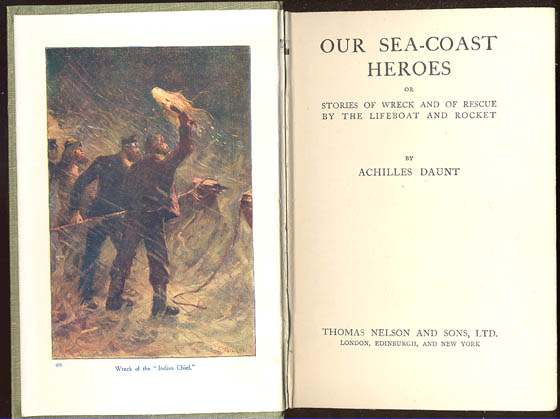
5288c. Daunt, Achilles. OUR
SEA-COAST HEROES or Stories of Wreck and of Rescue by the Lifeboat and Rocket.
London. Nd. c.1900. First published 1880’s. 185pp. Describes the origin and
history, as well as the principles of construction of the lifeboat and rocket
apparatus with accounts of rescues by the Royal National Lifeboat Institution.
Nicely embossed covers, clean, front hinge worn but otherwise clean, crisp.
(VG-) $34.
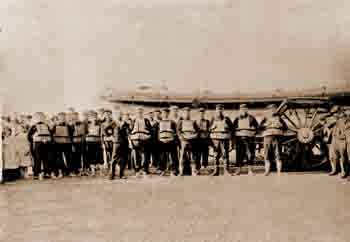
28193.
(photo) Hannah Fawcett Bennett Lifeboat, Hoylake
Lifeboat Station c.1908. Hoylake Lifeboat station is one of the
oldest on the coasts of Great Britain and Ireland, and was founded by the Mersey
docks and Harbour Board in 1803 and taken over by the RNLI in 1894. Hoylake has
always had a "carriage launched" lifeboat. At first the boat was
pulled to the water by a team of horses, frames for storing the harnesses can
still be seen on the wall in the current boathouse which was built in1899. Today
the lifeboat and carriage are towed by a caterpillar tracked Talus tractor which
has been specifically designed to launch carriage lifeboats. Since the RNLI took
over the station, two silver and five bronze medals have been awarded to the
crewmen of Hoylake. This clear close image is of the last Hoylake lifeboat to
use oars and sails - the Hannah Fawcett Bennett. The boat was manned by fifteen
lifeboat-men who, depending on weather conditions, rowed or sailed the boat. The
boat was pulled down to the water on a carriage drawn by horses belonging to
Jesse Baird. The horses were stabled next door to the Ship Inn in Market Street.
On hearing the explosion of the maroon, the horses would make their way down to
the lifeboat station even though, at times, they happened to be out working in
the district. The first call for the Hannah Fawcett Bennett came in August 1908,
and the vessel was withdrawn from service in March 1931. This original image on
postcard paper was inscribed on the back with a detailed description of the
“new” boat, noting “This Is Our Life Boat Crew Standing By The New Life
Boat…". When this photo was taken, the crew was still training on the new
boat and it had not seen service yet. Measuring 3 ½” x 5 ½”, photo is
close and clear. (VG+). $44.
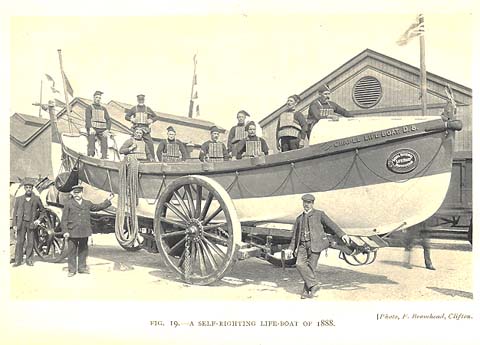
379.
Methley, Noel T., THE LIFE-BOAT AND ITS STORY.
London
. 1912. 318p. Embossed cloth. A sought after early source tracing the origins
and development of the life-boat. Includes great detail on the origins of the
life-boat, the birth of a system of rescue, evolution of the self-righter, steam
and motor life-boats, stations and equipment, life-saving services throughout
the world, rockets and wreck guns and much more. Illustrated with 67 superb b/w
photographs. An important source on the subject. Clean and tight, light wear to
wraps. (VG). $88.
8472. [glass magic lantern slides] OUR LIFE-BOAT
MEN. c.1900. Complete set of 8 early coloured magic lantern slides commemorating
the British life-saving services. This rare life-saving series consists of eight
coloured glass slides, each measuring 3 ¼" square, which were intended to
be projected in "magic lantern" projectors of the day. The slides tell
of the work of the life-savers in effecting rescues in marvelous images and
include (1) Title Slide picturing a typical lifeboat man in regulation lifebelt
[shown], )2) Launching the Lifeboat, (3) The Lifeboat on its Way to the Wreck,
(4) Throwing the Lifeline, (5) Joseph Cox Coxwain of the "Hope", (6)
The Wreck of the Norham Castle, (7) To The Rescue – the Lifebuoy, (8) Saved!
Set included original box cover with paper label, and original descriptive sheet
with historical script. This is a superb early life-saving collectors item and
would be quite lovely in a lit display. One slide cracked but tightly intact,
box cover only with label well worn but complete and intact. Quite nice. (G+).
$198 net.

1187. Leach, Nicholas. The
Waveney Lifeboats. Portishead. 2001. 88p. Soft wraps. Signed by
the author. A detailed history by a renown authority on the subject, of the
44ft Waveney class lifeboats, the first fast lifeboat to see service with the
RNLI. Thoroughly researched, containing many original and unusual illustrations,
the author traces the history of the Waveney lifeboat from development by the
United States Coast Guard to acquisition by the RNLI and subsequent service in
British waters. The 44ft lifeboat has operated in extreme sea conditions on both
sides of the Atlantic and the book contains descriptions of some of the
outstanding rescues in which Waveneys have been involved. The design met, and
often exceeded, the demands placed on it by the courageous men and women of the
lifeboat service. Detailed histories of every one of the Waveneys operated by
the RNLI are included, as well as several photographs of each lifeboat.
Profusely illustrated throughout, with many colour photographs, diagrams and
lists, this book is the definitive history of the Waveney lifeboats and a must
for the enthusiast. (M). $14.50.
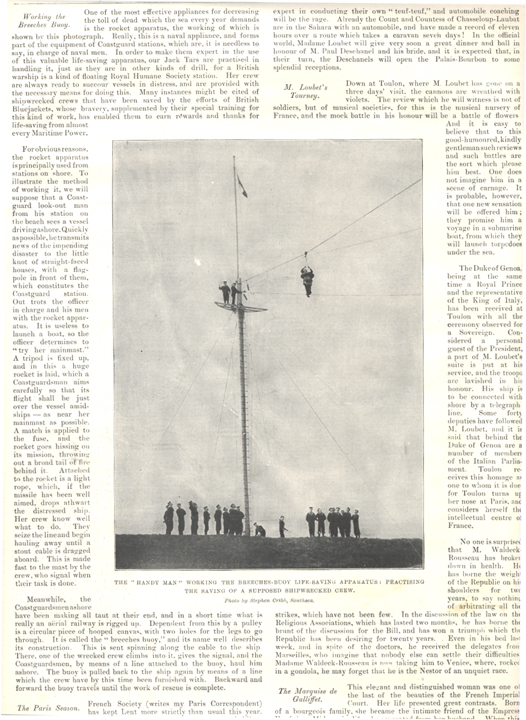
1161. Working
the Breeches Buoy. The Sketch Magazine. April 10, 1901. 1p. Disbound.
Half-page article details the use and workings of the breeches buoy with the
rocket apparatus of the Royal Coast Guards. Includes nice large illustration.
Clean, crisp. $34.
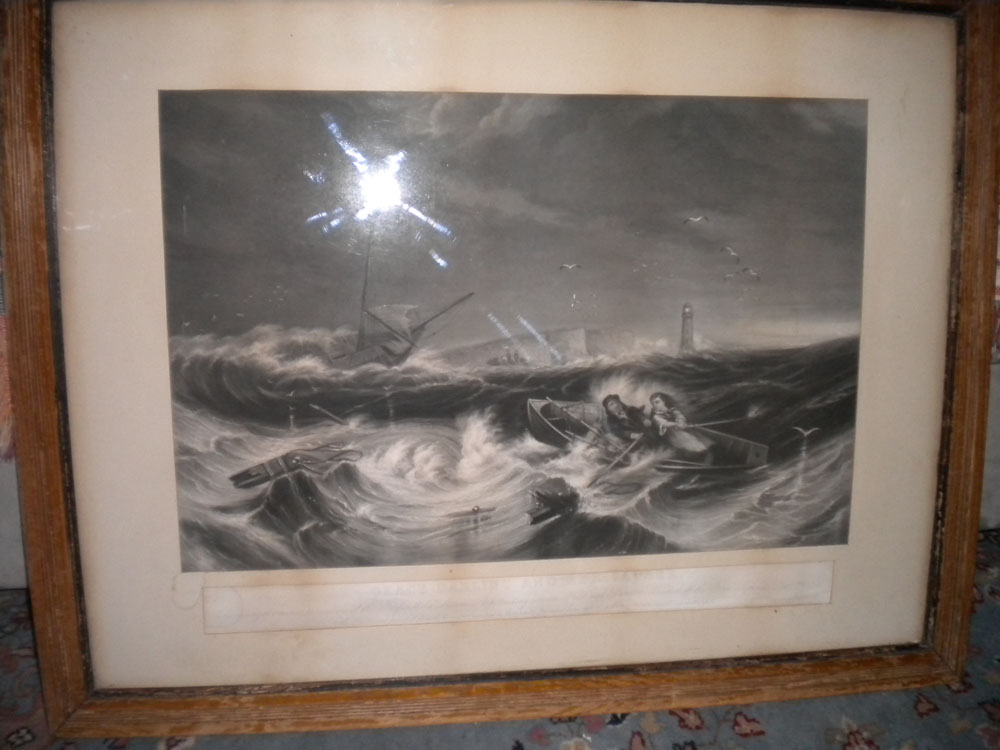
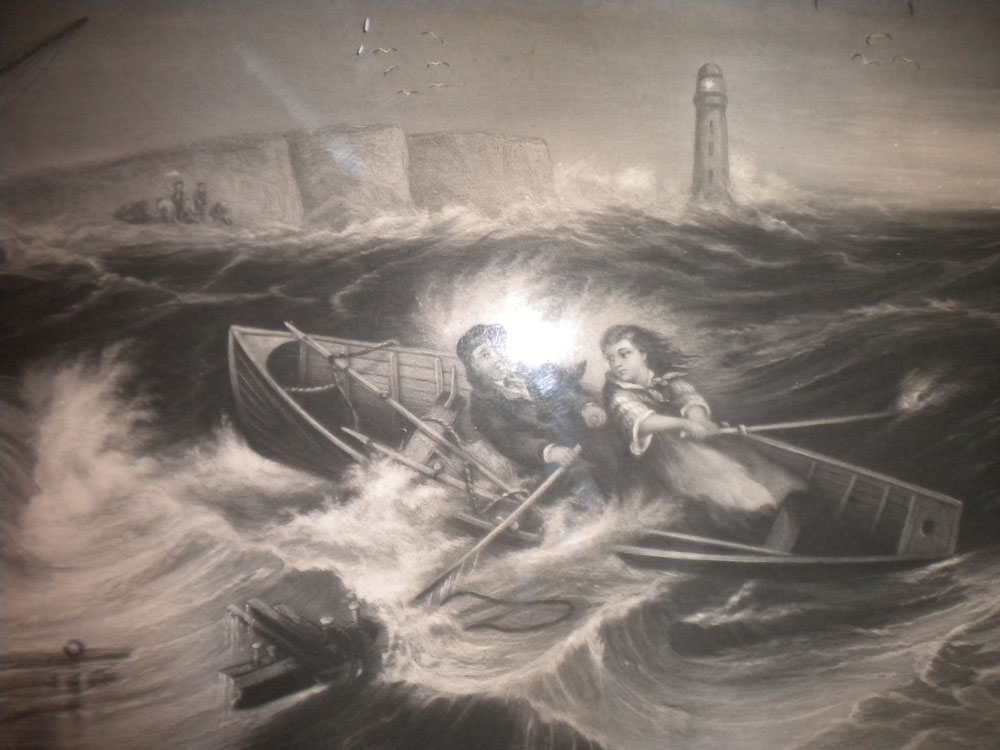
MF-01. (engraving) British
Heroine Grace Darling Rowing to a Rescue c.1890. “Grace Darling and
Her Father – Rescuing the Nine Survivors of survivors of the Forfarshire Steam
Ship trading between Hull and Dundee wrecked off the Fern Islands Sept 7 1838.
An historic record of female heroism inspired by humanity painted from life and
from sketches made upon the spot.” At about four o'clock in the morning of 7th
September 1838, the steamer 'Forfarshire' bound for Dundee struck the rocks near
the Fern lighthouse and broke in two. She sank immediately and only nine people
escaped the wreck. Grace Darling and her father rowed the lifeboat to the rocks
in heavy seas and saved the survivors in a remarkable and famous rescue. The
daughter of a lighthouse keeper, Darling grew up on Longstone in the Farne
Islands. Grace become the focus of national attention after the steamship
Forfarshire sank during a severe storm in September 1838. Nine people managed to
find refuge on nearby rocks, and Darling and her father battled rough water to
row to their rescue. The incident inspired numerous poems, paintings, and songs
and made Darling a virtual cult figure. This rare item features a detailed early
engraved image of the lovely heroine as she rows through rough seas, with the
lighthouse in the background. Good condition, needs some cleaning, I n original
wood frame. Measures 37” x 29” overall. $285.
2307. na. ANASTATIC DRAWINGS OF GOLD AND
SILVER MEDALS, PRESENTED BY SOVEREIGNS AND PUBLIC BODIES TO CAPT. GEORGE
WILLIAM MANBY, F.R.S. FOR SERVICES RENDERED IN THE SAVING OF LIFE AND
PROPERTY FROM SHIPWRECK: TO WHICH ARE ATTACHED A FEW OBSERVATIONS IN
CONNECTION WITH THE DEPOSITING OF THESE MEMORIALS. 1852.
Yarmouth. Printed for private circulation, 8vo. Inscribed by Captain Manby:
"Presented to Lieut. Col. Mason, East Norfolk Regt. By his much
respected friend George Will. Manby, Capt. R.N. May ’53." George
William Manby was most famous for his development of an early line mortars
and cannon for firing a life line to a ship in distress, which bears his
name. Born in 1765, Manby devoted himself to the development of
life-saving apparatus after experiencing a shipwreck while in his forties.
In addition, he developed the breeches buoy apparatus and was a founder of
the Royal National Lifeboat Institution. The early life-saving equipment
developed by this important inventor included early mortars, shot, heaving
lines, faking boxes, weatherproof pistol, life-car, buoys, signals,
lifeboats, and much more. Includes engraved portrait and twelve sepia
lithographic plates. In red blind- stamped cloth, lettered gilt on cover,
re-backed with new spine and endpapers. An important work by this noted
life-saver, extremely rare. (VG). $332.
2113. Manby, Capt. G. W., METHOD OF RESCUING
PERSONS FROM VESSELS STRANDED ON A LEEWARD SHORE.
[Gentleman’s Magazine bound volume July – December, 1821]. August
1821. 19p. George William Manby was most famous for his development of an
early line mortars and cannon for firing a life line to a ship in
distress, which bears his name. Born in 1765, Manby devoted himself to the
development of life-saving apparatus after experiencing a shipwreck while
in his forties. In addition, he developed the breeches buoy apparatus and
was a founder of the Royal National Lifeboat Institution. The early
life-saving equipment developed by this important inventor is detailed in
this scarce work. Illustrated with 22 early engravings including early
mortars, shot, heaving lines, faking boxes, weatherproof pistol, life-car,
buoys, signals, lifeboats, and much more. Extremely important early
information. In calf boards, embossed spine with some wear, overall clean
and tight. (G+). $124 net.
W-03. Cassells, Ian. A LIGHT WALK.
Scotland
. 1997. 152 p. Soft wraps. Whilst on duty in the cramped confines of
Muckle Flugga Lighthouse, Ian Cassells took to walking circuits round the
light station for exercise. With this background, when the northern
Lighthouse Board celebrated its Bicentenary in 1986, he made the
suggestion that in commemoration of the anniversary he carry out a
sponsored walk to raise money for the Royal National Lifeboat Institution,
calling at all the manned lighthouses on the Scottish mainland. It took
the author 58 days in which he covered over 1100 miles on foot – A Light
Walk! This is the story of his walk. (M). $19.95.
7109d. Ballantyne, R. M. THE LIFEBOAT - A Tale of
Our Coast Heroes. London. Nd. c.1880. 251p. DJ. 16MO. In this scarce title, the
author tells of the work of the lifeboat in wreck and rescue with the aid of
fictional characters. Through the many chapters one learns of the extensive
history of the lifeboat and the work of the Royal National Lifeboat Institution,
as well as their equipment including surfboat and rocket apparatus. With colour
illustrations. Very nice blue embossed binding, light wear, quite clean and
bright. (VG). $44.
8518. Cox, Barry. LIFEBOAT GALLANTRY –
R. N. L. I. MEDALS AND HOW THEY WERE WON. London. 1998. 454p. DJ. Just
released, imported from England. Since the foundation of the Royal
national Lifeboat Institution on 4 March 1824, just over 2,400 medals –
gold, silver, and since 1917 bronze – have been awarded for gallantry in
saving life from shipwreck. This is the first complete list of all such
awards to be published, together of details of the services involved; from
acts of individual heroism to the combined efforts of lifeboat crews:
hours spent at sea to effect rescues in raging storms: incredible feats of
endurance of men rowing and sailing lifeboats before the advent of motor:
the dangers of mines and aerial attacks in wartime, and much more. This is
not only a book of reference but is also a record of valiant deeds and
selfless efforts of those who have risked their own lives to rescue others
from the sea. Illustrated with some wonderful photographs, on quality
paper. A must for reading and reference. (M). $68.
826b. Warner, Oliver. THE LIFE-BOAT
SERVICE – A History of the Royal National Life-Boat Institution
1824-1974. London. 1974. 321p. DJ. To commemorate the first 150 years
of the Royal National Lifeboat Institution, distinguished naval historian
Oliver Warner was commissioned to write this history. The R.N.L.I. has
been responsible for saving nearly 100,000 lives and the author covers all
of this and more. In the well illustrated pages, Mr. Warner covers the
courage and matchless seamanship, the progress from pulling and sailing
boats to the diesel powered boats of today, the daily routine at the more
than 200 life-boat stations on the British Isles, and much more. A proud
and moving chronicle, with great detail. (VG). $48.
2113. Manby, Capt. G. W., METHOD OF RESCUING
PERSONS FROM VESSELS STRANDED ON A LEEWARD SHORE.
[Gentleman’s Magazine bound volume July – December, 1821]. August
1821. 19p. George William Manby was most famous for his development of an
early line mortars and cannon for firing a life line to a ship in
distress, which bears his name. Born in 1765, Manby devoted himself to the
development of life-saving apparatus after experiencing a shipwreck while
in his forties. In addition, he developed the breeches buoy apparatus and
was a founder of the Royal National Lifeboat Institution. The early
life-saving equipment developed by this important inventor is detailed in
this scarce work. Illustrated with 22 early engravings including early
mortars, shot, heaving lines, faking boxes, weatherproof pistol, life-car,
buoys, signals, lifeboats, and much more. Extremely important early
information. In calf boards, embossed spine with some wear, overall clean
and tight. (G+). $124 net.

24266.
[chromo lithograph print] LIFEBOAT PULLING UP TO A
VESSEL IN DISTRESS. c.1908. Superb large 19”h x 25”w early full
color chromo lithograph print of the Royal National Lifeboat Institution’s
lifeboat pulling up to a vessel in distress. The image is quite large and
details clearly the boat and its crew, pulling up to the side of the stricken
vessel as passengers climb down the sides on ropes. This superb full color
illustration was produced early in the last century and is nicely mated and
framed in a gilded frame. Print is quite distinctive and bright and has the look
and feel of an oil painting. This is in excellent condition and would be a
wonderful addition to any museum display or to your living room. (VG+). $278
net.
9228. (2). Walthew, Kenneth. FROM ROCK AND TEMPEST.
London. 1971. 175p. George William Manby was most famous for his development of
an early line mortars and cannon for firing a life line to a ship in distress,
which bears his name. Born in 1765, Manby devoted himself to the development of
life-saving apparatus after experiencing a shipwreck while in his forties. In
addition, he developed the breeches buoy apparatus and was a founder of the
Royal national Lifeboat Institution. The life of this important inventor and his
efforts in the development of this early life-saving equipment is detailed in
this scarce work. Illustrated with 21 photographs including early mortars,
canvass sling, the forerunner to the breeches buoy, and more. (VG). $32. Now
$16.
2307. na.
ANASTATIC DRAWINGS OF GOLD AND
SILVER MEDALS, PRESENTED BY SOVEREIGNS AND PUBLIC BODIES TO CAPT. GEORGE
WILLIAM MANBY, F.R.S. FOR SERVICES RENDERED IN THE SAVING OF LIFE AND
PROPERTY FROM SHIPWRECK: TO WHICH ARE ATTACHED A FEW OBSERVATIONS IN
CONNECTION WITH THE DEPOSITING OF THESE MEMORIALS. 1852.
Yarmouth
. Printed for private circulation, 8vo. Inscribed by Captain Manby:
“Presented to Lieut. Col. Mason,
East Norfolk
Regt. By his much respected friend George Will. Manby, Capt. R.N. May
’53.” George William Manby was most famous for his development of an
early line mortars and cannon for firing a life line to a ship in
distress, which bears his name. Born in 1765, Manby devoted himself to the
development of life-saving apparatus after experiencing a shipwreck while
in his forties. In addition, he developed the breeches buoy apparatus and
was a founder of the Royal National Lifeboat Institution. The early
life-saving equipment developed by this important inventor included early
mortars, shot, heaving lines, faking boxes, weatherproof pistol, life-car,
buoys, signals, lifeboats, and much more. Includes engraved portrait and
twelve sepia lithographic plates. In red blind- stamped cloth, lettered
gilt on cover, re-backed with new spine and endpapers. An important work
by this noted life-saver, extremely rare. (VG). $332 / Reduced to $148.
Page updated March 21, 2022
Procedure
to order items:
1. I suggest that you call us or
email to check on availability of any item that you would like other than
recent books. As items go quite quickly, please call and leave a message to
reserve items that you would like. I will return your call, hold the items and
await your letter or credit card information. We will also weigh the items and
advise postage.
2. You may then call or email credit
card information, or forward a check in the mail.
Most items are mailed US Priority Mail
or UPS. Additional information on our "Ordering Page".
Massachusetts residents must add 6.25% sales tax.
Can't find what you are looking for?
We can help you find that needed book or item.
mailto:[email protected]
How to reach us:
Kenrick A. Claflin & Son Nautical Antiques
1227 Pleasant Street, Worcester, MA 01602
Phone (508) 792-6627
All
text and illustrations on web site Ó
James W. Claflin . 03/21/2022
All rights
reserved. Use prohibited without written permission.
-

|



















